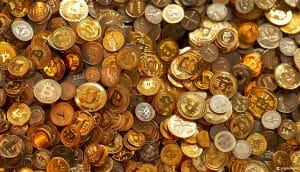Coins vs Utility Tokens vs Security Tokens – What’s The Difference?
Disclaimer: The Industry Talk section features insights by crypto industry players and is not a part of the editorial content of Cryptonews.com.

Tokenization is one of the proponents of the blockchain which will likely stand the test of time. The act of tokenizing something, means giving it representation on a blockchain. Anything can be tokenized, from wine, to cars, to mortgages to ownership in artwork. Holding a token that is backed up by a physical asset, gives the holder actual ownership over that product. Let’s take wine as a use case. When you tokenize a bottle of fine wine, you have the token which proves your ownership as the blockchain creates a permanent, immutable record of your token. You might collect wine as an investor or you might just want to drink it. If you are an investor you can actually take receipt of the wine, and store it, or not have to worry about the logistics, while the wine is stored safely at the vineyard or cellar.
The same is true for art. With art, you can hold a token which represents an actual piece of art, or you can have an NFT which is a minted piece of artwork. Either way, the product is yours and there’s no getting around the blockchain. One of the main benefits of the blockchain is that it is nigh-on impossible to tamper with the code. That’s because, with a distributed ledger, the information is held across many hundreds of nodes (computers) located globally. For someone to crack the code, it would cost a huge amount of time and energy and frankly would just not be worth the bother. Instead, miners are rewarded and incentivized for mining tokens, rather than hacking them.
What Are Security Tokens?
A security in the traditional financial markets is any tradable financial asset, like a stock, real estate, a commodity, an ETF or an option. It gives the holder representation of ownership in a PLC or rights of ownership of an option. When an investor purchases a security they are given a digital representation of ownership of that asset, by way of security token, which is stored on the blockchain.
You can create security tokens by either taking an actual asset and then turning it into a token or by mining or staking on a blockchain.
Coins vs Tokens
A coin like Bitcoin is a means of currency. These are fungible, meaning you can exchange one coin for any other in the same currency and it would be worth the same. It’s only value is to make payments or used as a speculatory tool for trading purposes eg. Will the value of BTC go up or down? So a coin represents a unit of currency or a store of value.
What is a Utility Token?
A token is a digital representation of an asset. Many crypto protocols or projects issue tokens in order to raise funds for their project. They do this through selling tokens through an ICO or through offering staking of their token in return for a passive yield. Tokens are not considered as a currency, rather a representation of the value of what stands behind them.
The Limitations of Security Tokens
The limitations of security tokens lie with the SEC and the regulations they impose on them. Security tokens are highly regulated, while utility tokens are exempt from Fed interference, making utility tokens much more attractive for holders, users, issuers and investors. However the unregulated nature of utility tokens makes this a wild west for trading, giving scammers the opportunity to exploit users.
The SEC defines a security if it fulfils these three criteria, this is known as the Howey Test:
- It is an investment of money;
- The investment is in a common enterprise;
- There is an expectation of profit from the work of the promoters or the third party.
Any token that does not fulfill these three criteria is known as a Utility token. Whereas Security tokens were made with the purpose of investments through a security token offering, utility tokens help fund ICOs and build an internal source of economy for the project.
Convergence is one project that is bridging the gap between the traditional capital markets and the blockchain by tokenizing assets, thereby turning them into security tokens and bestowing upon them the security and stability that comes with regulated assets. This decentralized interchangeable asset protocol, brings real-world assets into the DeFi realm by tokenizing them and fractionalizing them. The tokenized assets are placed in the liquidity pool on ConvX and can be traded by any user. A product like this which merges the capital markets with the blockchain can retain the inherent safety and oversight of the regulated markets.
The Bottom Line:
Tokenization is able to foster a new era of financial market interaction for users that is safe and near instantaneous to make a transaction. With tokenization comes the ability to fractionalize assets, bringing a lower barrier to entry for both users and to generate more funds for projects, while saving time and money for companies looking to reconcile transactions.
{no_ads}



